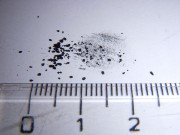A Jan. 24, 2013 news item on ScienceDaily features love triumphing over hate where tetracationic rings are concerned,
Northwestern University graduate student Jonathan Barnes had a hunch for creating an exotic new chemical compound, and his idea that the force of love is stronger than hate proved correct. He and his colleagues are the first to permanently interlock two identical tetracationic rings that normally are repelled by each other. Many experts had said it couldn’t be done.
On the surface, the rings hate each other because each carries four positive charges (making them tetracationic). But Barnes discovered by introducing radicals (unpaired electrons) onto the scene, the researchers could create a love-hate relationship in which love triumphs.
The Jan. 24, 2013 Northwestern University news release by Megan Fellman, which originated the news item, probes into the nature of the problem and its solution (Note: A link has been removed),
Unpaired electrons want to pair up and be stable, and it turns out the attraction of one ring’s single electrons to the other ring’s single electrons is stronger than the repelling forces.
The process links the rings not by a chemical bond but by a mechanical bond, which, once in place, cannot easily be torn asunder.
The study detailing this new class of stable organic radicals will be published Jan. 25 [2013] by the journal Science.
“It’s not that people have tried and failed to put these two rings together — they just didn’t think it was possible,” said Sir Fraser Stoddart, a senior author of the paper. “Now this molecule has been made. I cannot overemphasize Jonathan’s achievement — it is really outside the box. Now we are excited to see where this new chemistry leads us.”
…
The rings repel each other like the positive poles of two magnets. Barnes saw an opportunity where he thought he could tweak the chemistry by using radicals to overcome the hate between the two rings.
“We made these rings communicate and love each other under certain conditions, and once they were mechanically interlocked, the bond could not be broken,” Barnes said.
Barnes’ first strategy — adding electrons to temporarily reduce the charge and bring the two rings together — worked the first time he tried it. He, Stoddart and their colleagues started with a full ring and a half ring that they then closed up around the first ring (using some simple chemistry), creating the mechanical bond.
When the compound is oxidized and electrons lost, the strong positive forces come roaring back — “It’s hate on all the time,” Barnes said — but then it is too late for the rings to be parted. “That’s the beauty of this system,” he added.
Most organic radicals possess short lifetimes, but this unusual radical compound is stable in air and water. The compound tucks the electrons away inside the structure so they can’t react with anything in the environment. The tight mechanical bond endures despite the unfavorable electrostatic interactions.
The two interlocked rings house an immense amount of charge in a mere cubic nanometer of space. The compound, a homo[2]catenane, can adopt one of six oxidation states and can accept up to eight electrons in total.
“Anything that accepts this many electrons has possibilities for batteries,” Barnes said.
“Applications beckon,” Stoddart agreed. “Now we need to spend more time with materials scientists and people who make devices to see how this amazing compound can be used.”
For anyone interested in the details of the work, here’s a citation and link to the paper published in Science,
A Radically Configurable Six-State Compound by Jonathan C. Barnes, Albert C. Fahrenbach, Dennis Cao, Scott M. Dyar, Marco Frasconi, Marc A. Giesener, Diego Benítez, Ekaterina Tkatchouk, Oleksandr Chernyashevskyy, Weon Ho Shin, Hao Li, Srinivasan Sampath, Charlotte L. Stern, Amy A. Sarjeant, Karel J. Hartlieb, Zhichang Liu, Raanan Carmieli, Youssry Y. Botros, Jang Wook Choi, Alexandra M. Z. Slawin, John B. Ketterson, Michael R. Wasielewski, William A. Goddard III, J. Fraser Stoddart. Science 25 January 2013: Vol. 339 no. 6118 pp. 429-433 DOI: 10.1126/science.1228429
This is paper is behind a paywall.
